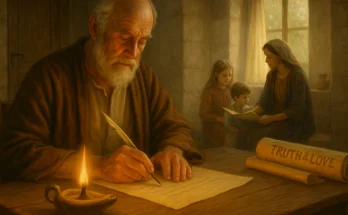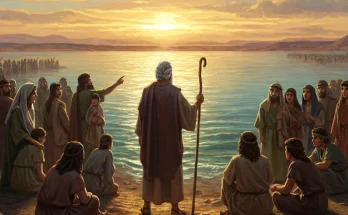Why the Day of the Lord Still Matters
What kind of day could shake the heavens, judge nations, and still offer hope to the faithful? Throughout the Bible, the Day of the Lord stands out as a powerful and sobering theme. From the prophets of old to the writings of the apostles, it marks a moment—or series of moments—when God intervenes directly in human history. It’s a day of reckoning, but also of restoration.
In the Old Testament, the Day of the Lord often referred to times when God judged Israel or other nations for their rebellion. The language is intense—darkness, fire, trembling, and cosmic signs. Yet even in the middle of judgment, God always left a door open for repentance.
Then, in the New Testament, the message expands. Jesus speaks of the Day with both warning and promise. Paul and Peter echo the urgency. John, in Revelation, shows it as part of the final victory of Christ.
So why does this ancient theme still matter? Because we’re still living in the tension between now and not yet. God’s justice hasn’t changed. His mercy hasn’t either. The Day of the Lord reminds us that history has a direction, and God is not silent.
As we explore both the Old and New Testament connections, we’ll discover a unified message: the Day of the Lord isn’t just about fear—it’s about faith, hope, and the glory of God breaking through.
Old Testament Foundations of the Day of the Lord
When we turn to the Old Testament, the Day of the Lord comes into focus with striking power. The prophets didn’t speak of it lightly. They described it as a day of divine interruption—when God would act suddenly, decisively, and unmistakably in the affairs of humanity.
The Prophets Speak Boldly
Isaiah, Joel, Amos, Zephaniah, and Malachi all warned about the Day of the Lord. Though they spoke to different generations, their messages shared common threads. They called out sin, idolatry, injustice, and spiritual complacency. God’s people had turned from Him, and judgment was coming.
But this wasn’t just about local politics or bad harvests. The prophets described something far more dramatic—something cosmic.
Cosmic Signs and Holy Judgment
The Day of the Lord wasn’t only about battles or invasions. It was marked by signs in the heavens.
Joel declared,
“The sun shall be turned to darkness, and the moon to blood, before the great and awesome day of the Lord comes.” (Joel 2:31, ESV)
These signs weren’t just poetic—they pointed to something supernatural. God wasn’t working behind the scenes anymore. He was stepping forward in full view.
Zephaniah added weight to the warning:
“The great day of the Lord is near… a day of wrath is that day, a day of distress and anguish.” (Zephaniah 1:14–15, ESV)
This language told the people that God would no longer tolerate rebellion. Judgment was no longer far off. It was near.
Historical Fulfillments and Foreshadowing
We see these warnings come to life in Israel’s history. The Assyrian invasion of the northern kingdom and the Babylonian destruction of Jerusalem were terrifying fulfillments. God used foreign nations as instruments of His judgment. Yet even in wrath, He remembered mercy. In every prophetic message, there was always a call to return—a chance to repent.
A Pattern Set in Motion
These Old Testament moments weren’t just past events. They set a prophetic pattern. The Day of the Lord would come again. Every time God judged and restored, He pointed forward to something greater. This pattern prepares us for the New Testament, where the message expands—but the heart remains the same: God is holy, just, and faithful to His word.
New Testament Fulfillment and Expansion
As we move into the New Testament, the Day of the Lord doesn’t disappear—it becomes even more vivid. Jesus and the apostles take what the prophets began and expand it with fresh urgency and deeper meaning.
Jesus Carries the Prophets Forward
In Matthew 24 and Luke 21, Jesus speaks directly about coming judgment and the end of the age. He echoes the Old Testament prophets, but He also raises the stakes.
Now the focus shifts to personal responsibility. Jesus warns His disciples to stay awake, to watch, and to remain faithful. The Day of the Lord is no longer just about nations—it’s about hearts.
The Apostles Add Clarity and Urgency
Apostle Paul, writing to the Thessalonians, gives a clear warning:
“The day of the Lord will come like a thief in the night.” (1 Thessalonians 5:2, ESV)
That means it won’t come with advance notice. We must live ready every single day.
Apostle Peter adds another layer of weight:
“The day of the Lord will come like a thief, and then the heavens will pass away with a roar…” (2 Peter 3:10, ESV)
This isn’t just about cities falling. It’s about creation itself being shaken. Yet Peter also points to hope—a new heaven and a new earth are coming.
Revelation: The Final Picture
In the book of Revelation, the Day of the Lord reaches its full climax. John describes judgment, tribulation, and the return of Jesus in glory. We see bowls of wrath, cosmic signs, and the fall of Babylon. But we also see a victorious Lamb and the New Jerusalem.
A Broader, Deeper Fulfillment
The New Testament shows us that the Day of the Lord isn’t a single event. It’s a sweeping moment of judgment, resurrection, and renewal. Even the cross and resurrection are part of this picture. Jesus’ death defeated sin. His resurrection launched the beginning of the end-times.
Now we live in between—between His first coming and His return. The Day of the Lord reminds us that history is moving toward a glorious conclusion. And we’re invited to be part of it.
Comparing Eschatological Views: Dispensational vs. Partial Preterist
When we study the Day of the Lord, we quickly discover that not all believers interpret it the same way. While all agree it points to God’s decisive action in history, the timing and meaning of that day can vary. Two common views—Dispensationalism and Partial Preterism—offer different lenses through which we can understand this prophetic theme.
Dispensational View: A Future Day of Judgment
In the Dispensational perspective, the Day of the Lord is still to come. It takes place after a future event called the rapture, when believers are taken up to meet Christ. What follows is a literal seven-year tribulation period filled with intense judgment, global upheaval, and the rise of the Antichrist.
This view sees prophecy as a timeline with clear stages. Revelation, according to this model, is mostly unfulfilled. The plagues, trumpets, and bowls of wrath are future events that will unfold during this coming tribulation.
Importantly, Dispensationalists draw a sharp line between Israel and the Church. Prophecies related to Israel are seen as distinct from those related to the Church. God’s promises to national Israel are expected to be literally fulfilled in the future.
At the end of the tribulation, Christ returns visibly and physically to earth. He defeats evil, judges the nations, and establishes a literal thousand-year reign—the millennial kingdom—on earth. For many believers, this view offers a detailed roadmap of end-time events.
Partial Preterist View: A Past Day with Ongoing Meaning
The Partial Preterist view takes a different approach. It teaches that many Day of the Lord prophecies were fulfilled during the first century, particularly in the events leading up to the fall of Jerusalem in AD 70.
When Jesus warned of judgment in Matthew 24, He was speaking to His own generation. Partial Preterists point to verses like Matthew 24:34 — “Truly, I say to you, this generation will not pass away until all these things take place.”
They also interpret much of the apocalyptic language symbolically. Phrases like “the sun will be darkened” or “stars will fall” are seen as metaphors for the fall of nations or the end of an old covenant system. In this view, the destruction of the temple was a major fulfillment of the Day of the Lord for Israel.
However, Partial Preterists still believe in Christ’s physical return. That final moment of resurrection, judgment, and renewal is yet to come. The difference is that much of the groundwork has already been laid.
They also see the Church not as a pause in God’s plan, but as its fulfillment. God’s promises to Israel find their completion in Christ and His body, the Church.
Both views take the Day of the Lord seriously. One looks ahead to a future global event; the other sees a past fulfillment with ongoing impact. Understanding both helps us appreciate the richness—and mystery—of God’s prophetic Word.
Key Similarities and Differences
Even though Dispensationalists and Partial Preterists see prophecy through different lenses, they still share important ground.
Both agree that the Day of the Lord is a time when God steps into human history. It brings justice for the wicked and deliverance for the faithful. They also agree that Christ will return physically and gloriously. That hope remains central in both views.
However, the differences are worth noting. Dispensationalists believe the Day of the Lord is still entirely in the future. Partial Preterists, on the other hand, see some of it fulfilled already—especially in the first century.
They also interpret Scripture differently. Dispensationalists lean toward a literal reading of prophetic texts. Partial Preterists often see the imagery as symbolic and tied to covenantal shifts.
The role of Israel is another dividing point. One sees a future for national Israel; the other sees the Church as the continuation of God’s promises.
Here’s a side-by-side comparison to make it clearer:
| Key Element | Dispensational View | Partial Preterist View |
|---|---|---|
| Timing | Day of the Lord is entirely future | Partially fulfilled in AD 70 |
| Interpretation | Prophecy taken literally | Prophecy often seen symbolically |
| Israel’s Role | National Israel still has a future role | Church fulfills Israel’s spiritual purpose |
| Christ’s Return | Future, physical, and global | Future, physical, and global |
Though different in approach, both views help us stay alert for God’s unfolding plan. The Day of the Lord calls us all to readiness.
Living in Light of the Day of the Lord
So how should we live, knowing the Day of the Lord is real? Peter answers that question with a challenge:
“Since all these things are thus to be dissolved, what sort of people ought you to be…” (2 Peter 3:11, ESV)
We’re called to live with readiness—not fear. God’s mercy always comes before His judgment. He gives space to repent, reflect, and return. That alone shows His heart is not to destroy, but to redeem.
Because of that, we walk in holiness. Not perfection, but a daily pursuit of what pleases God. We also walk in hope. The Day of the Lord reminds us that evil won’t win. Christ will return, justice will be served, and creation will be renewed.
We don’t know the exact timing, but we do know the message. Whether we view the Day of the Lord as mostly past or mostly future, one thing is certain—it still speaks to us today. Now is the time to stay awake. Now is the time to be faithful, loving, and bold in our witness. Let’s live with urgency, not anxiety. Let’s live like people who believe the King is coming.
Final Thoughts on Day of the Lord
As we’ve seen, the Day of the Lord is not just a single event. It’s a repeated pattern of God breaking into history—sometimes to judge, always to redeem. This day ties together His justice and His covenant love. He doesn’t act out of anger alone. He moves with purpose, calling His people back to Himself.
Throughout Scripture, the Day of the Lord shows us that God is not distant. He steps in when things seem darkest. He shakes what needs to fall so that what is eternal can remain. Whether we lean toward the Dispensational view or the Partial Preterist view, the call is the same. We are challenged to trust God’s plan. We are urged to prepare our hearts.
That preparation isn’t just about avoiding judgment—it’s about living with purpose. Holiness, faithfulness, and hope mark those who truly understand what this day means. The Day of the Lord should never lead us to fear. Instead, it points us toward a faithful hope. God will finish what He started. So let’s be people who live with eyes wide open. Let’s anchor ourselves in His promises and walk in the light of His coming.
Frequently Asked Questions (FAQ) The Day of the Lord
1. Is the Day of the Lord a single event or multiple moments? The Bible presents it as a repeated pattern—God breaking into history in judgment and redemption, with a final fulfillment still ahead.
2. How is the Day of the Lord different from the Second Coming? They are closely related. The Second Coming is part of the final Day of the Lord when Christ returns to judge and restore.
3. Why does the Bible use cosmic signs to describe the Day of the Lord? These signs show the seriousness of God’s actions. They symbolize massive change—both in history and in God’s covenant dealings.
4. Should Christians fear the Day of the Lord? Not at all. While it brings judgment for the unrepentant, it brings hope and victory for those who walk in Christ.
5. What does the Day of the Lord mean for us today? It reminds us to stay spiritually awake, live in holiness, and trust that God is bringing His plan to perfect completion.




